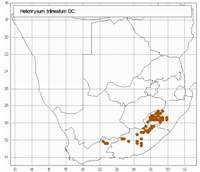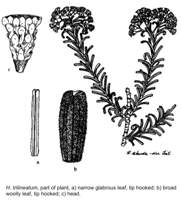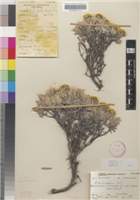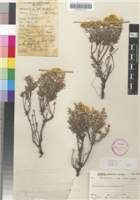Common names:
Hokubetsi, Phefshoana-ea-loti (SS)
Origin of name:
trilineatum = leaves marked with three parallel lines
Diagnostic characters:
Bright yellow bractsSmall leaves, bicolouredMedium sized heads in compact branched inflorescenceWoody shrub
Description:
Twiggy rounded shrub c. 150 mm �1m high, old branches bare, rough with leaf scars, branchlets greyish-white woolly, closely leafy. Leaves 3�25 x 1�5 mm, linear or oblong, apex mucronate, acute, subacute or obtuse, but generally appearing very blunt because of the recurved tip, base broad, half-clasping, margins revolute, upper surfaces minutely gland-dotted, glabrous, cobwebby or greyish-white woolly, lower surface white-woolly, ribbed by the parallel veins. Heads heterogamous or rarely homogamous, campanulate, 4�6 mm long, 4�8 mm across the radiating bracts, often woolly or cobwebby at the base, many in terminal compact corymbose clusters. Involucral bracts in c. 5 series, graded, closely imbricate, pellucid, outer pale golden-brown, inner more or less equaling flowers, tips obtuse, bright canary-yellow, minutely radiating. Receptacle honeycombed. Flowers 25�60, (0�) 4�13 female, 19�53 homogamous. Achenes c. 1 mm, barrel-shaped, with duplex hairs. Pappus bristles many, about equaling corolla, scabrid, bases cohering by patent cilia.
Flowers mainly from August to February, but can be found in flower in almost any month.
Distribution:
Often forms large colonies on steep mountain slopes or on the summit plateau of the Drakensberg with grasses or with other shrubby species (fynbos) or among rock outcrops or in rocky gullies. Ranges from the Koudeveld Mountains and Sneeuberg, NW. and N. of Graaff-Reinet, across the mountains to the Stormberg, Great Winterberg, Katberg, Witteberg and Cape Drakensberg, thence along the Drakensberg and its outliers on the Cape-Lesotho-KwaZulu-Natal border as far north as Mont aux Sources; also on the Lesotho mountains.
Grassland, Savanna and Succulent Karoo Biomes.
Notes:
Very variable in leaf size and indumentum and has the curious habit, shared with related and other species, of sometimes producing broad grey-woolly leaves at the base of the branches, narrow glabrous bright yellow-green ones at the tips. But more usually plants are either grey-woolly or green, growing in mixed communities or in pure stands of grey-leaved or green-leaved plants. Green-leaved plants are sometimes confused with H. tenuifolium and H. witbergense, but H. tenuifolium has minute appressed-trichomes, not gland dots, on the upper leaf surface, while H. witbergense has differently shaped leaves.
Not eaten by stock, but used as fuel, the branches burning readily when green.
Taxonomy:
Literature:
Helichrysum trilineatum DC., Prodr. 6: 192 (1838); Harv. in F.C. 3: 245 (1865); Moeser in Bot. Jb. 44: 286 (1910); Hilliard, Compositae in Natal 203 (1977).
Type:
Cape, Wittebergen, Dr�ge 3760 (G-DC, holo.).
Synonym(s):
Gnaphalium trilineatum (DC.) Sch. Bip. in Bot. Ztg 3: 172 (1845).
Helichrysum alveolatum DC., Prodr. 6: 192 (1838). G. alveolatum (DC.) Sch. Bip. in Bot. Ztg 3: 171 (1845). H. trilineatum var. tomentosum Harv. in F.C. 3: 245 (1865). Type: Cape, Wittebergen, Dr�ge 3759 (G-DC, holo.; BM, iso.).
H. trilineatum var. glabriusculum Harv. in F.C. 3: 245 (1865). Type as for H. trilineatum.
H. trilineatum var. brevifolium Harv. in F.C. 3: 245 (1865). Type: KwaZulu-Natal, 100 miles inland at 6 500 ft, Sutherland (K, holo.).
Vouchers:
Esterhuysen 19715 (BOL; NBG; NU); Hilliard 5442 (E; K; NU; PRE; S); Hilliard & Burtt 6609 (E; K; MO; NU; PRE; S); Tyson 494 (SAM); Wright 451 (E; K; NH; NU; S).



